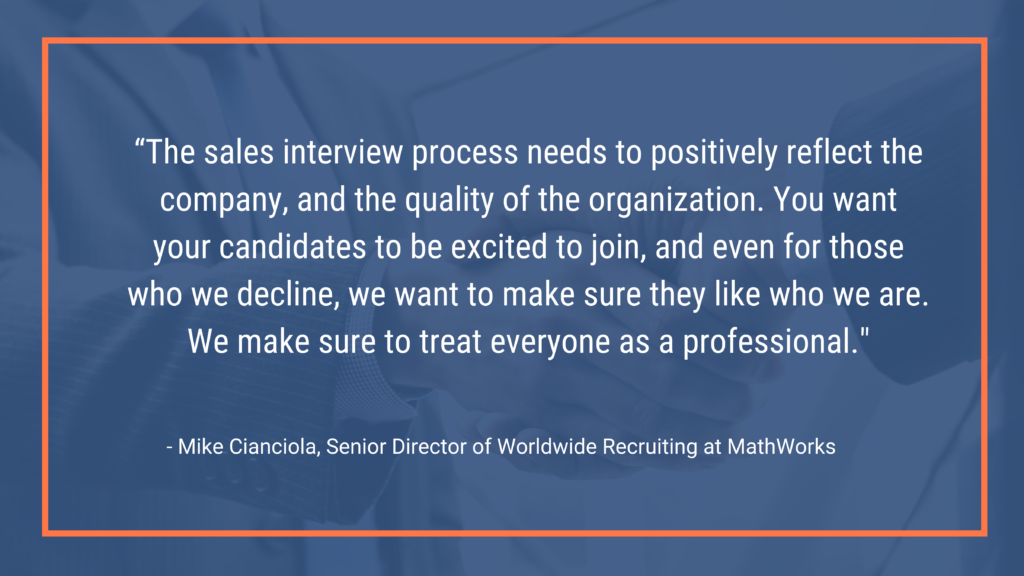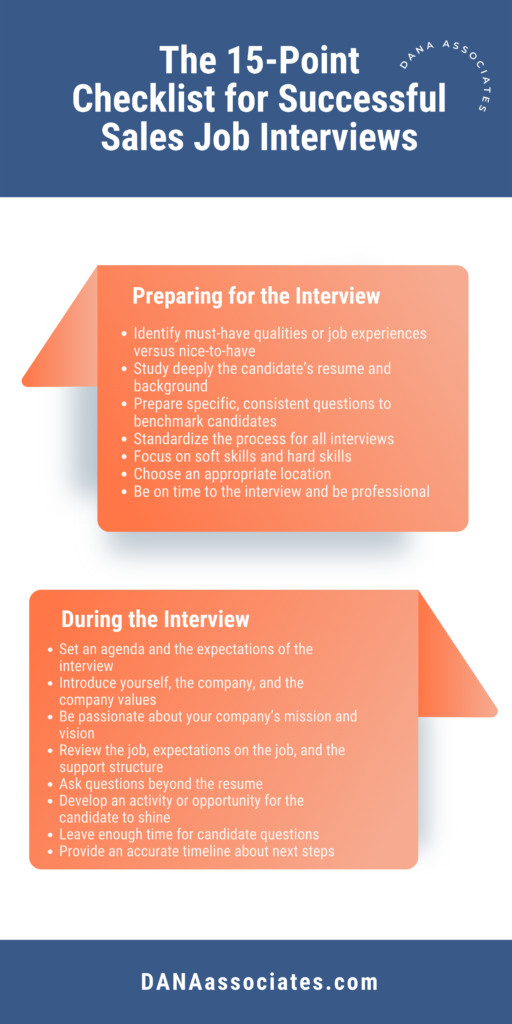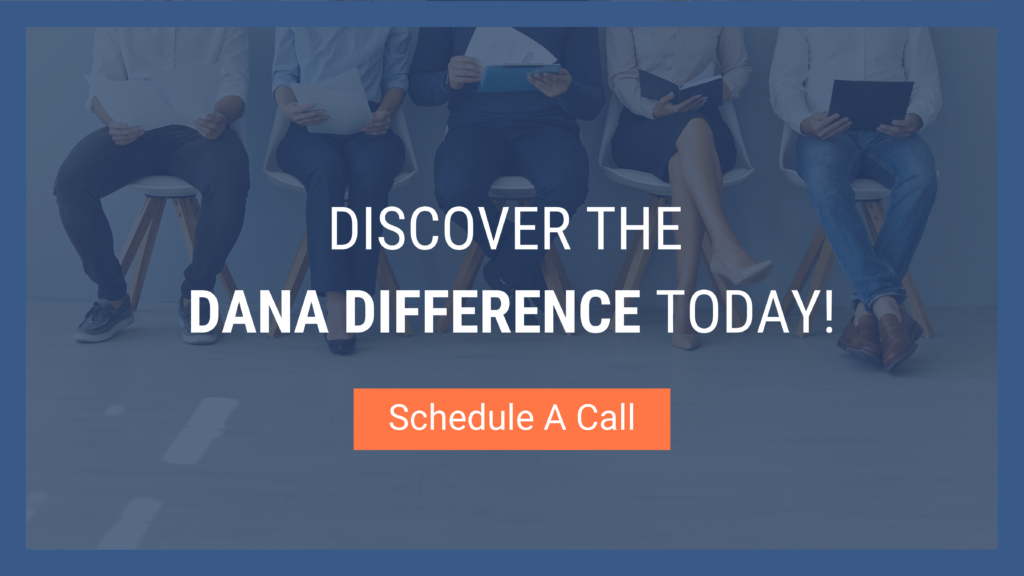
Hiring managers know that attracting the right talent in this competitive market is essential to the emerging and enduring success of their sales organizations. After the effective, accurate, and engaging job description, the interview process is a next critical step in a strong recruitment program. Our team put together the best practices for successfully conducting an interview for sales jobs.
By investing resources and time into defining the interview process, companies can efficiently identify the right talent to fit their company culture while providing an exemplary experience for candidates. Consider that a well-structured, thoughtful interview process is the first step in employee retention. Employees want good pay and benefits, but they also want to be valued and appreciated, and that starts with the interview.
“The sales interview process needs to positively reflect the company, the quality of the organization,” said Mike Cianciola, senior director of worldwide recruiting at MathWorks (Natick, Massachusetts). Over two decades, Cianciola has developed a structured and formal hiring process for MathWorks, a leading developer of advanced mathematical computing software for engineers and scientists, with over 5,000 employees worldwide.
You want your candidates to be excited to join the organization, he said. And even for those who we decline, “We want to make sure they like who we are,” he said. “We treat everyone as a professional.” They may walk away from the company following an interview. Still, they may be back because of our interview process and how they were treated, looking for another opportunity down the road.

So how can hiring managers best learn how to conduct an interview for sales roles to engender that kind of connection from candidates and earn the best outcomes?
How to Conduct an Interview Part One: Prepare to Get to Know Your Candidate
The best way to get to know candidates is to sit down with them, face-to-face, over several interviews. But before that stage, Jason DeAmato reviews the resume and then schedules a 15-minute first-round phone screen to determine if the candidate will move to the next level in the interview process. DeAmato is an award-winning author, entrepreneur, sales trainer, and CEO/founder of ConversionCoach (Newburyport, Massachusetts), a sales acceleration platform that tracks and analyzes reps’ behaviors and their outcomes.
In that first 15 minutes, “I like to get a sense of how well they prepared, what they know about our company, and how comfortable they are on the phone,” DeAmato said. Especially for an inside sales role, he uses that time as a first-level assessment of a candidate’s skill with a phone conversation, a base tool of sales reps. If the candidate passes that first test, a more involved process begins with a longer phone call, then at least two more live or video calls, although he prefers face-to-face conversations.
At MathWorks, the interview process involves a minimum of four people working in a collaborative framework. “We have a recruiter who knows the market hiring manager; the application engineer who technically supports the salesperson; and then there is the sales support person,” Cianciola said. It is the recruiter who makes the initial call, to explore “how responsive the person is, how prepared they are — have they gone to our website, do they understand our product, do they understand the industries they would be selling to,” and the like, he said.
But when a position opens, a kickoff meeting is called by the recruiter for the team to evaluate and review the job description to ensure it is correct and complete. Through group discussion, the job description is refined and improved, if necessary, Cianciola said.
That discussion importantly includes the must-have skills versus the nice-to-have skills for a position. The list becomes an anchor, Cianciola said, a stabilizing reference throughout the interview process, helping in those situations, for example, when everyone loves a candidate, but then realizes they lack the skills to do the job.
As well, during the kickoff meeting, each interviewer’s role is defined for the duration of the process, including the areas of the resume to focus on and each must-have skill is assigned for further research and inquiry. This way, no team member asks overlapping questions of the candidate, and each team member’s role is defined in the deep-dive into evaluating and analyzing the products or solutions the candidate sold, verticals they sold into, the type of sales they were in, the relationships they built, their approach to selling, and more.
The multi-faceted approach MathWorks employs, described more below, is designed to identify candidates who can grow in the role and change with the company.
“We’re going to invest in, train, and support a new hire with tools and people,” Cianciola said. “We’re not looking to plug a gap; we’re looking for a person to stay many years.”

How to Conduct an Interview Part Two: Prepare Your Questions
Even after 20 years of interviewing, DeAmato still prepares a set of questions for the longer second interview.
“I’m a big believer in discipline,” he said, and the same overconfidence that can come from being in sales a long time can jeopardize your performance as an interviewer when you walk in unprepared.
“I don’t want to forget to check all of the boxes when recruiting, especially in a second interview,” he said. “The first interview, I’m comfortable with all the memorized connecting,” but for the second, he includes a targeted set of questions and a specific agenda that varies based on the candidate and the position.
Establish Rapport, Set an Agenda
“I always like to, first of all, make the candidate feel comfortable, because interviews can be so stressful. If someone is nervous, I’m not going to get a good sense of who they are,” DeAmato said. “If an interview is a trailer for a movie, I want to get past the trailer; I want to know the movie.”
After the initial getting acquainted, an agenda establishes expectations, if they have not already been provided in a pre-interview communication.
“It’s important to do that because so often when someone comes into an interview, they only want to talk about their resume and work experience,” DeAmato said. “I’m not interested in that as much as I am interested in getting to know them and their values: Who they are, where they come from, and what their passions are.”
But some people are uncomfortable talking about those areas, he said, and an agenda helps him redirect when the conversation lapses into a work-history-only discussion.
Share Values
The interview agenda should include the sharing of core values, the cultural cornerstones that guide a company beyond principles of productivity.
Soon into an interview, DeAmato moves to the values portion: 20-30 minutes on the candidate’s values; the next 10-15 minutes on his values; and finally, the company’s values. If all of those are aligned, there’s a huge advantage, he said; it provides a sense of trust, and the pay and the benefits become almost secondary considerations to the conversation.
Sharing values recognizes that both parties are making an important decision. There’s a discussion that goes beyond skills.
Cianciola agrees. “We want to make sure this individual can follow our values,” not just know how to sell, he said. “The values are important. We integrate our company values in everything we do.”
Review the Job, Expectations, Support Structures
Candidates deserve an environment of full disclosure in their interviews, understanding who they will work with; how they fit in the organization on a day-to-day basis; the tools available to them; their territory; the support they get; and how they will be evaluated.
“You have to convey the opportunity; people want to know what the job is,” DeAmato said. “You need to tell them the good and the bad. You can’t tell them it’s all rainbows and butterflies. Give them the challenges so they have fair expectations and are not in any way surprised” once they are hired.
Full disclosure takes away the element of surprise and also allows the company an opportunity to demonstrate the investment it makes into its team members.
“We want them to understand how we set them up for success,” Cianciola said. “We want them to know that there is an investment in them.” The interview is both a setting of expectations and an apprising of the training, the tools, and the support systems candidates have available to them, that are in place, to support their success.
How to Conduct an Interview Part Three: Look Beyond the Resume
“It is important to have a well-balanced team, and I need to get to know people,” DeAmato said. “I want to uncover their adaptability — the instincts of the candidate.”
Getting to know whether a candidate fits well with the values and culture of a company requires hiring managers to look beyond the itemized accomplishments of education, work history, and sales performance to include soft skills such as communication, self-motivation, problem solving, leadership, teamwork, and the ability to collaborate.
“I will pay attention to writing, grammar, and design, from a general standpoint, but I am not overly obsessed with the resume,” DeAmato said. With a candidate for a more junior position, you have to look beyond the resume for its lack of experience, he said, and for the senior sales position, beyond career move rates. “There is so much that contributes to that,” DeAmato said.
Beyond the two-dimensional resume, a way DeAmato uncovers the three-dimensional person is to have them talk about their passions outside of work. Let’s say it’s music. He might ask about their favorite band, then favorite album, and favorite song.
“A lot of it is to see how they talk about what they love, and see how articulate they are, their curiosity and level of knowledge,” he said. If someone says their passion is music, and digging deeper reveals little substance, that’s instructive.
“I want enthusiastic. Fired up. Articulate. And to find out how deep they can go,” he said. “If you’re not getting passionate and not lighting up when you’re talking about your passion, you’re not going to light up when you’re talking about my software.”
At MathWorks, part of evaluating soft skills rests in the way candidates start their well-structured interview day — with a presentation.
“A sales rep should feel comfortable to talk in front of people, no need for a flashy presentation, just be yourself.” Cianciola said. “We are looking at this presentation for the candidate to provide us information about themselves.”
The presentation provides the same information to every interviewer, giving the interviewers space to ask other questions in one-on-one sessions. The presentation provides a who-are-you slide, information about hobbies and interests, and anything else the candidates care to share about themselves. Then, the candidates first walk through their resume, including explaining their career progression, gaps, and reasons for joining other companies, and then they review their sales approach. At the end, the candidate answers the question of why they want to join MathWorks.
“We’re asking them to share a sales success story they are proud of. The interview team may ask clarifying questions during the presentation and follow-up with more in-depth questions during their one-on-one interviews. The presentation is a steppingstone to the ono-on-one interviews,” Cianciola said.
Beyond the obvious information they provide, the presentations offer a distinct opportunity for a candidate to represent themselves as they would in a client setting with a small audience. Likewise, the presentation provides a specific opportunity for the company to evaluate the person, as the manager and candidate work together in the presentation preparation. The hiring manager gets to see how the candidate responds to and integrates feedback, and evaluates how well the candidate works with others. If, for instance, there is a candidate who has received feedback and the feedback was ignored in the creation of the presentation, it can raise a flag, Cianciola said.
“I’ve hired very successful people, but if they don’t have the soft skills, working with teams, accepting and giving feedback,” they are going to be a bad fit, Cianciola said.
Leave Time For, Invite Questions
The company is making a decision for a hire, and the sales candidate is making an important life choice. The only way both can come to their conclusions is if the line of communication runs both ways. Leave time for the candidate to ask their questions.
And going further, Cianciola invites communication outside the interview. He tells them: “Call. Email anyone from the interview team. Please make sure your questions are answered. It is not going to change anything,” he said. There will be no penalty for follow-up qAt DANA Associates, we know the hiring process is an investment in your company. A carefully crafted interview is one step in the immersive, field-tested method we use to generate the best outcomes, for candidates and clients, in hiring experienced professionals to fill upper-level sales positions.
Be Consistent, Revise Periodically
Build in evaluation sessions after interviews to redefine the roles and responsibilities, if necessary, and make any other changes to your process.
“By having a consistent process, we can understand where to tweak it to make it better,” Cianciola said. “There is flexibility, but there is consistency. If you don’t have consistency, there are no controls.”
Best Practices on how to Conduct an Interview From Dana Associates
At DANA Associates, we know the hiring process is an investment in your company. A carefully crafted interview is one step in the immersive, field-tested method we use to generate the best outcomes, for candidates and clients, in hiring experienced professionals to fill upper-level sales positions.
Contact us today to discover the DANA difference for yourself and to see why we are the top sales talent recruiting agency in the Boston area.

